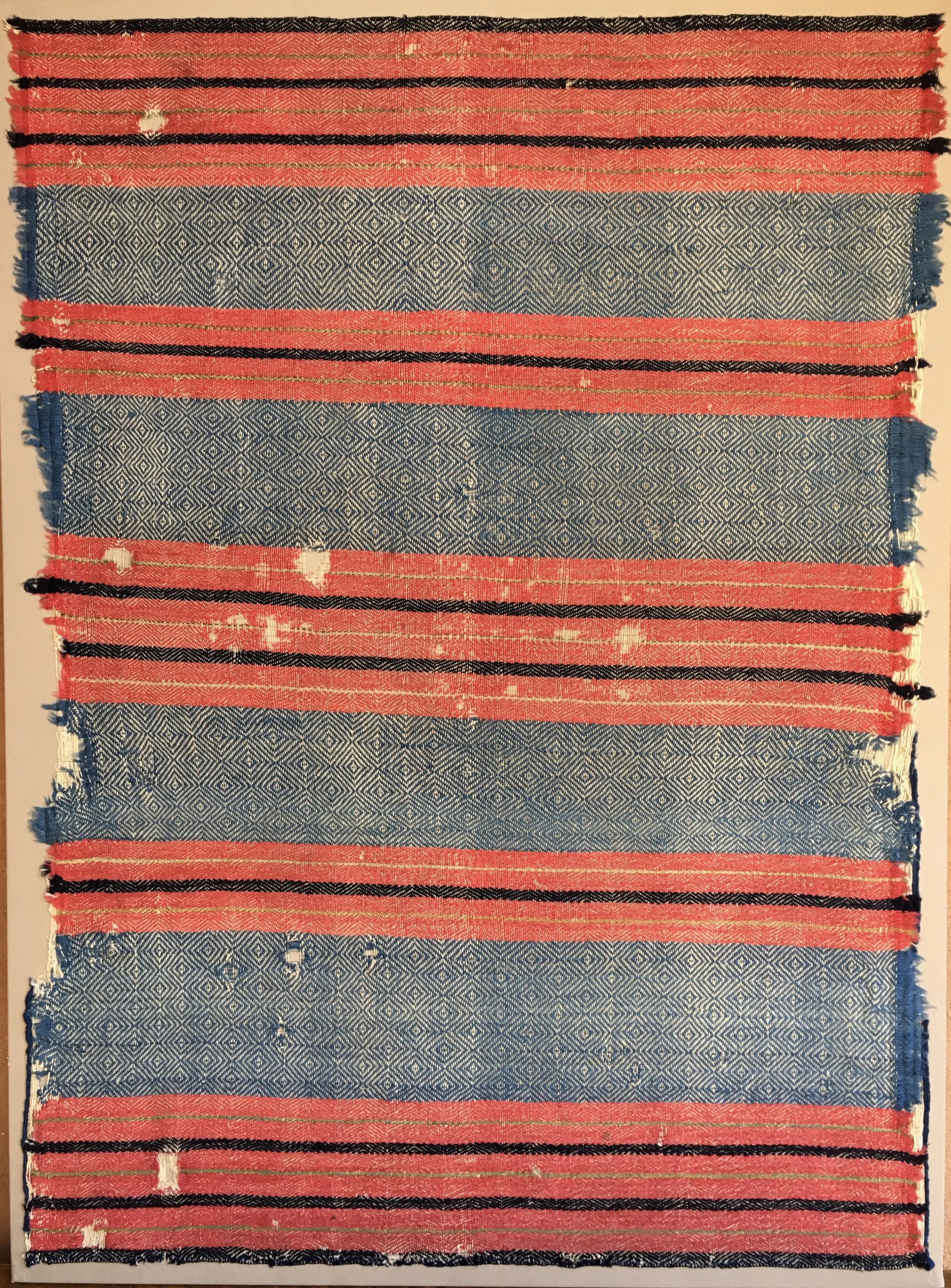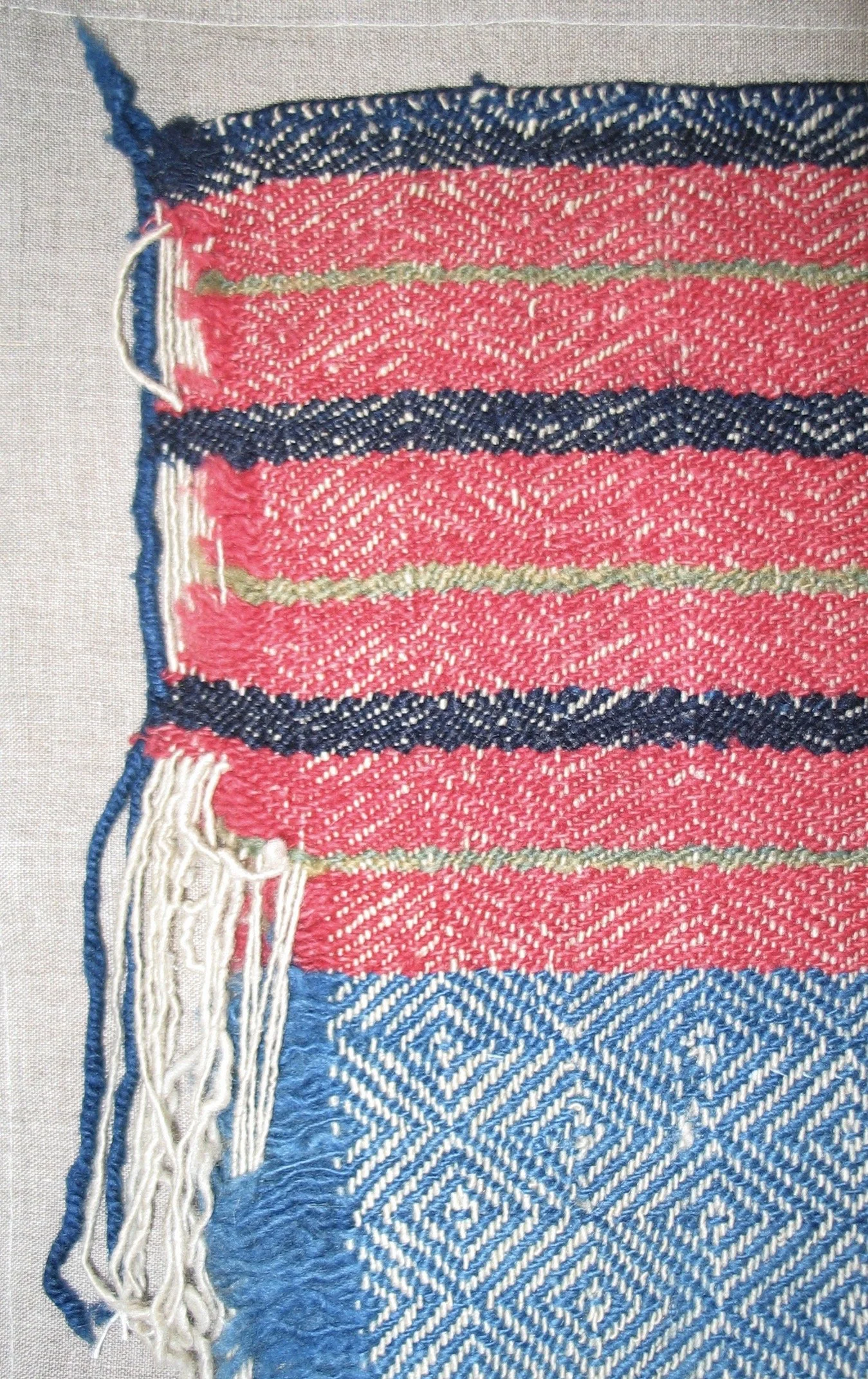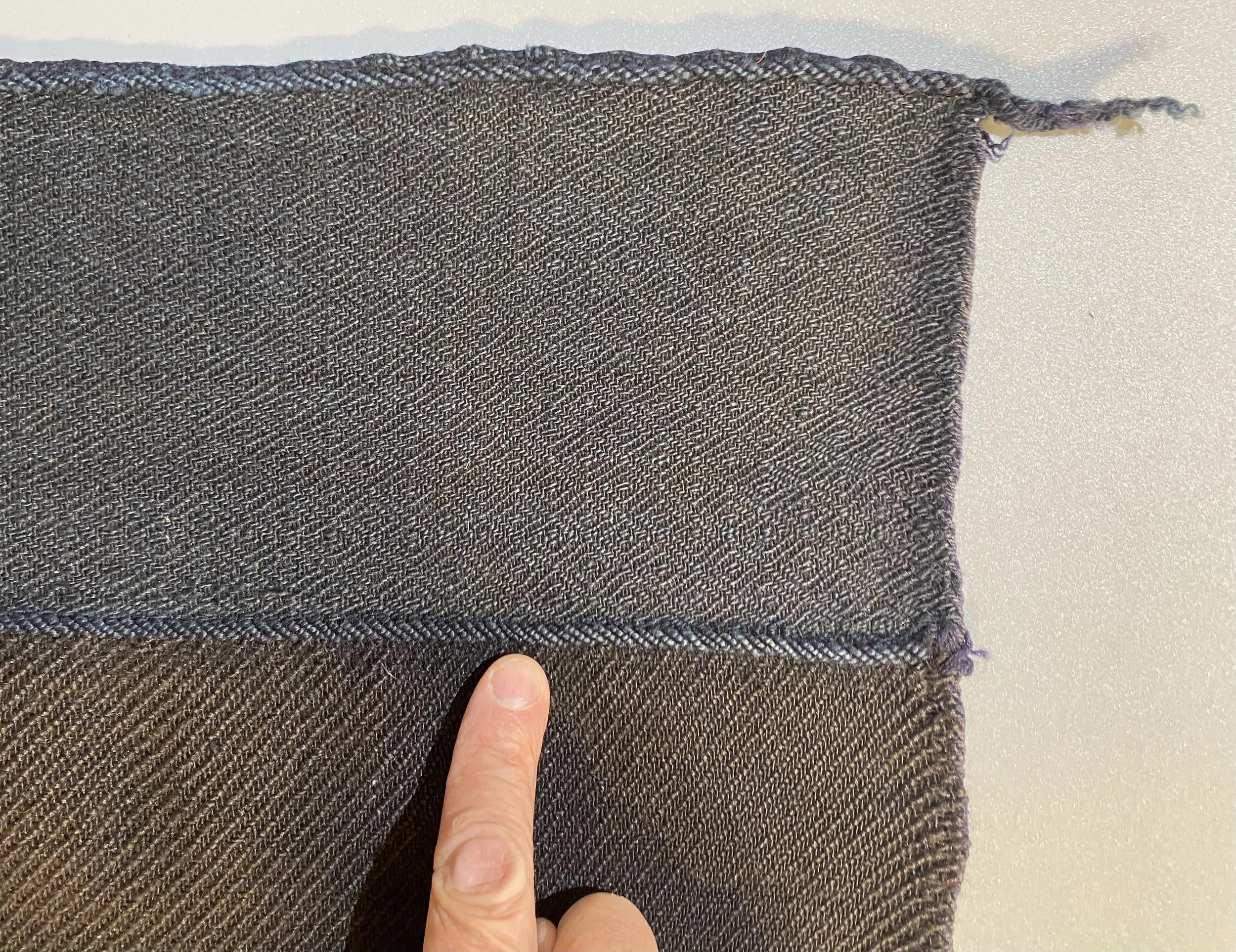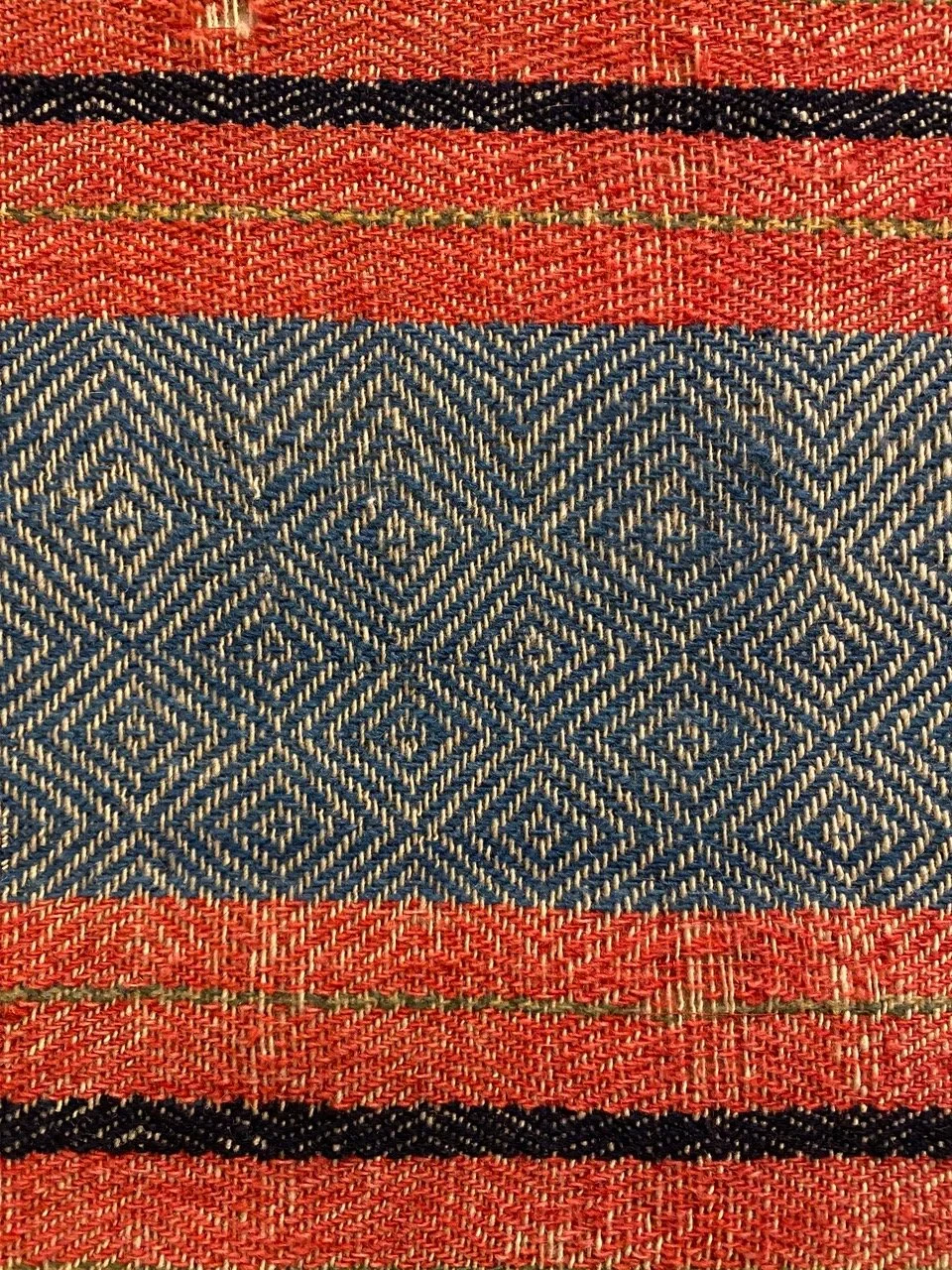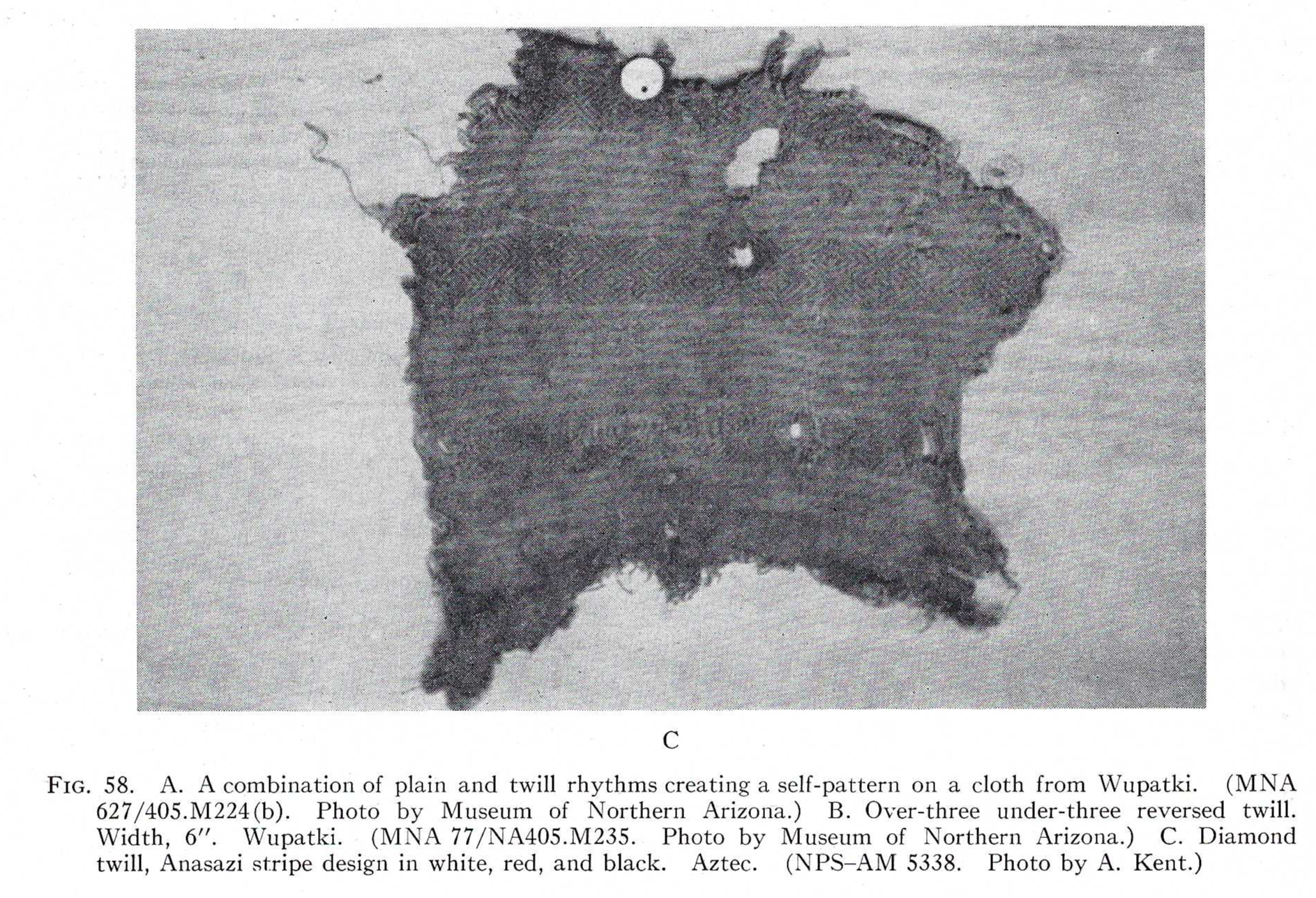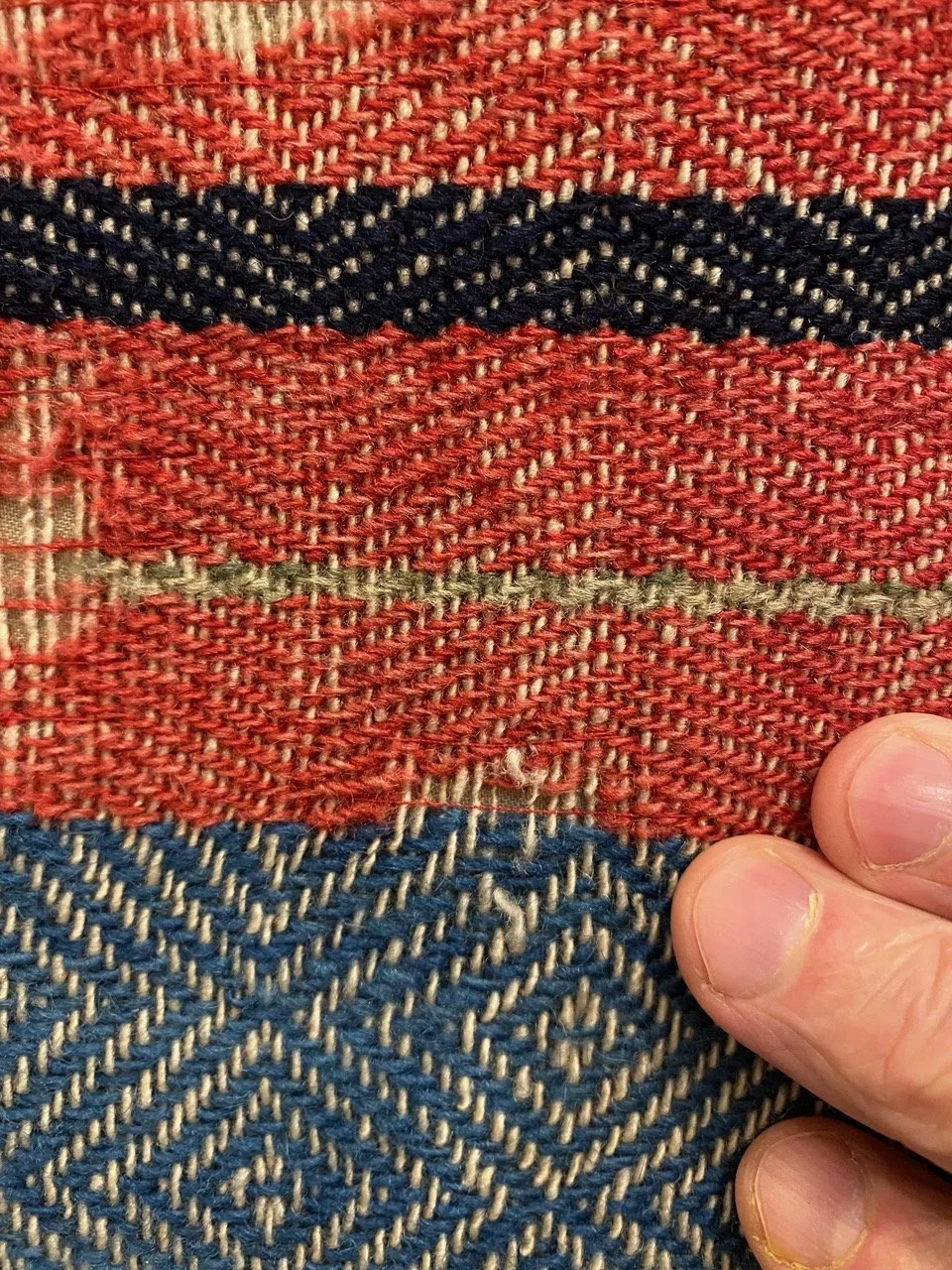Abstract
This paper presents an analysis of a Navajo twill blanket believed to be from the 18th century, predating significant Euro-American influence on Navajo weaving traditions. Through an examination of the blanket's materials (including churro wool and coarse bayeta), construction techniques (specifically the use of open twill), and design elements (such as the banded pattern and color palette), the paper argues for its early origins. By contrasting the blanket's characteristics with those of later Navajo weavings and contemporary Pueblo textiles, this study suggests that the blanket represents a transitional period in Navajo weaving history, demonstrating a shift away from Puebloan influence while retaining unique early Navajo characteristics.
Earliest Known Navajo Blankets
My enduring interest lies in early Southwest blankets, which I believe offer insight into the weaving traditions of the region before the influence of modern materials and techniques. This paper focuses on a specific blanket from my collection. By examining this blanket’s characteristics, I believe the information points to a likely creation period within the 18th century. While available records indicate that the earliest documented Navajo blankets date to the late 18th —with no known examples definitively predating 1775[1] —prehistoric blankets from the Southwest, discovered in caves and burials, have been dated using scientific methods to between 400 and 1,000 years ago. I posit that early proto-historic blankets must exist, and I believe the example presented here represents one such piece.
A Twill Woven Blanket
This twill woven blanket was collected by an American soldier around 1848 in relation to the Mexican/American War period and belonged to a family in Texas. The blanket measures 50 inches by 36½ inches, and it is made entirely of wool. It is woven in an open twill pattern that alternates between diamond twill for the background and herring bone twill for the banded zones. The blanket is beautiful in its design, coloration and complex twill. This blanket holds a deep beauty, especially with its imperfections making it all the more human. In addition, it has a garment like quality. I have never felt a Navajo blanket with such a thin and supple feel (Figure 1).
Figure 1. Navajo blanket with diamond and herring bone twill. 50” by 36.5”, 18th century
All of the colored wefts, except for the red, are handspun single-ply wool dyed with natural dyes such as indigo and rabbit brush—though these have not been tested. The red weft is raveled bayeta, a commercially woven wool cloth that has been dyed with cochineal (tested). Since the Navajo did not have direct access to the highly valued cochineal dye, they traded for the wool cloth. They then unraveled it, taking the loose yarns and weaving those into their blanket, and giving the term “raveled bayeta”.
The blanket has light indigo blue as the background color. Within this blue background are five, primary zones of red. These zones are themselves made up of a repeating, smaller banding system consisting of red divided equally by a thin band of yellow and green wefts. Three of the five zones are the same and consist of three, repeating red bands. These zones anchor the two ends and the center. The remaining two zones are smaller and consist of two red bands that divide the three zones.
Navajo or Pueblo?
Identifying this blanket as Navajo and not as Pueblo is critical regarding the claim for the early date. This blanket is identified as Navajo, but does have Puebloan qualities that have made me pause. One major characteristic shared by both is the use of the open twill technique.
Puebloans have used open twill weaving since pre-historic times and they continue to use it throughout the 20th century. In contrast, Navajo weaving used open twill up until around 1800[2]. After this, Navajo weaving stopped using this technique and instead used the closed twill technique where the warps were entirely covered up by weft.
There are three characteristics that make this weaving Navajo. The first is the use of corner embellishments or tassels. One corner on this blanket has remnants of a corner tassel dyed in deep indigo blue. Navajos would add yarn to the corners to embellish them and this corner shows those pieces of yarn worn down to their base.
The second are weft selvage cords constructed of 2 – 3 ply cords. On both sides of this blanket are remnants of weft selvage cords. On one side the selvage remains as one piece of 2 – 3 ply yarns. On the other side, the weft selvage is unwound, showing two cords of 3-plied yarns hanging separately. Puebloan weavers do not embellish their corners with tassels, and their weft side cords typically have 2-plies instead of 3-plies[3]. (Figure 2)
Figure 2. A corner of the blanket showing the remains of the augmented tassel at the top, left corner in dark indigo yarns. On the far left are the two remaining weft selvage cords, three plies that have unwound at the half way point into the two parts.
The third reason is the lack of supplemental weft to define the transition from one type of twill to another. Pueblo mantas create a supplemental weft between changes in types of twill. This weft appears like a raised boundary between the blanket parts. This twilled blanket has no use of supplemental wefts between herring bone twill and diamond twill. Navajo do not use the supplemental weft technique (Figure 3).
Figure 3. Zuni manta with diagonal and diamond twill. The finger is pointing to the supplemental weft added to separate the diamond from the diagonal twill. This is found in Pueblo textiles, but not Navajo.
On a more subjective note, there are other qualities that suggest Navajo. The rectangular shape, or serape, is more of a Navajo trait, whereas square or wider than long is Puebloan. The idiosyncratic qualities of how the twill roams outside its borders is more a Navajo than Puebloan quality (Figure 4). Puebloan weavers are systematic in their weaving creating a blanket with few anomalies. In contrast, Navajo weavers vary their process, resulting in more unique designs on their blankets.
Figure 4. Notice in the light blue diamond twill how at the top the diamonds turn into herringbone before reaching the red zone. This is showing how the Navajo often will play outside the box with their weaving, a trait less characteristic of Pueblo weavers.
Lastly, the degree of color variation suggests a Navajo hand. Having a light blue indigo background mixed with red that also incorporates dark blue, green and yellow is characteristic of Navajo. The use of light indigo blue is rare and I have never seen a blanket where the entire background color is dedicated to a light blue. Nowhere have I seen this in a Pueblo weaving. While the Puebloan used varied colors, there is restraint to the overall color effect. Puebloan blanket backgrounds are typically natural brown or carded grey wefts, and do not use the high degree of color contrast as seen in this blanket.
A Prehistoric Cotton Twill Fragment
During my research, I discovered a notable parallel in Kate Peck Kent’s The Cultivation and Weaving of Cotton in the Prehistoric Southwestern United States. The publication features a photograph of a prehistoric cotton remnant exhibiting the same twill layout as the blanket under consideration[4]. Specifically, the diamond twill in the remnant represents the background color, while the herring bone twill defines the banded portions (Figures 5 and 6). This layout is further analyzed with a pattern drawing in Figure 81.E[5]. This remnant is noted as being excavated at the Aztec Ruin and dated to no later than the mid-13th century. This remnant does not have supplemental weft between the twill weaves. To my knowledge, it is not known when the Puebloans starting using supplemental weft. The existence of this remnant in relation to this twill blanket reinforces the assimilation of Pueblo weaving techniques being acquired by the Navajo.
Figure 5. Photo of the Prehistoric cotton remnant with diamond and herringbone twill. Taken from Kate Peck Kent, The Cultivation and Weaving of Cotton in the Prehistoric Southwestern United States, New series, vol. 47, no. 3 (Denver: University of Denver for the American Philosophical Society, 1957).
Figure 6. Fig 81E showing the drawing of the remnant in Figure 5 with the diamond and herringbone twill. Kate Peck Kent, The Cultivation and Weaving of Cotton in the Prehistoric Southwestern United States, New series, vol. 47, no. 3 (Denver: University of Denver for the American Philosophical Society, 1957).
The existing Pueblos in the Southwest were built by the descendants of the prehistoric people that made up the Anasazi and other groups. The Anasazi wove textiles with feathers, dog hair, yucca and, eventually, cotton. With the arrival of the Spanish Colonialists in North America in the 1540s, sheep were introduced for the first time. Pueblo weaving flourished and by the 1600s, the Spanish were needing/forcing weavings from them.[6]
The Navajo, a northwestern Athabascan people, arrived from the north into the Southwest around 800 years ago.[7] While the relationship between the Pueblos and the Navajo has been difficult and complicated, this did not stop the Puebloans from teaching the Navajo how to weave. The Navajo were fast learners and entrepreneurial in nature, and by the early 1700s, the Navajo were considered expert weavers.[8]. This prehistoric cotton fragment and the blanket under consideration shows the influence of Pueblo weaving on the Navajo.
What Makes This Blanket So Early?
Open Twill
The design technique of open twill is the strongest feature that confirms the proposed date. As already stated, open twill was no longer used by the Navajo after the early 1800s.
Open twill means that half of the design is created by the wefts, and the other half by the warps. This results in much less weft and thus less weight. Early classic Navajo twill weaving (1820-1860) has blankets without exposed warps since by this period, the warps are all covered in a closed twill weave.
Churro Wool
The Spanish brought with them to the New World a breed of sheep called churro. Prior to their arrival, there were no sheep in North America. The churro sheep were ideal for the Southwest as they thrived on the desert landscape environment. In addition, their wool has little lanolin in it and the wool fibers are long and parallel to each other making any processing for yarn an easy chore.
This blanket has all the qualities of early, churro wool. The white warps are a golden color of white and all the other wefts of hand spun yarns have a worsted quality in contrast to woolen. The yarn is smooth and long with little side fuzz as characteristic in later woolen yarns.
Coarse Bayeta
Bayeta is the term used for manufactured cloth that came out of North America and Europe. The natives living in the Southwest had no natural dyes that came close to the pure color of red. Most natural dyes available to them were variations of brown and rust. The deep red we have come to love is called cochineal. Cochineal was a dye discovered in Mexico and comes from the small bugs that live on the opuntia cactus. With the discovery of this intense color, an industry developed in dying manufactured blankets with cochineal, known as bayeta. Bayeta was sold and traded to the Navajo, where they then took the cloth, unraveled it, and then re-wove the strands of yarn into their blankets. (Figure 7)
Figure 7. A close up of the warp and weft. Notice the red, raveled bayeta yarns and how much more worsted they are (smooth and tightly spun) compared to the hand spun light blue weft.
The earliest documented Navajo blanket with bayeta is from the Patchwork Cloak (two Navajo blankets sewn together as an archaeological garment now in the Museum of Northern Arizona) and these raveled yarns date to 1750 – 1800.[9] These coarse yarns measure .8 mm, z-spun, are naturally worsted, and light rosy crimson in color and likely dyed with cochineal.[10] The red bayeta on my twill blanket is identical in all regards to that found on the patchwork cloak. The diameter of the raveled yarn in this twill blanket is .8 – 1 mm, with a z-spin and the color is a light, rosy crimson dye tested as cochineal. It’s interesting to note that all the other hand spun yarns in the blanket are made to match the size of the raveled bayeta.
Banded Blankets
A simple banding system is characteristic of early Navajo weaving. The earliest blankets feature this straightforward design. While these early styles of blankets continued to be produced throughout Navajo weaving history, the absence of design elements beyond this banding in the blanket under consideration suggests a relatively early origin.
Conclusion
While documented Navajo blankets from the 18th century remain elusive, this example presents a compelling case for its early age based on the factors examined herein. Although lacking a definitive collection date, the materials, construction methods, and design elements strongly suggest an early origin. The preponderance of the evidence suggests a Navajo origin; although no single feature is definitively Navajo, it is unlikely that several predominantly Navajo characteristics would be combined in a Puebloan piece. This textile offers a rare glimpse into the transition from Puebloan to Navajo weaving. It incorporates Puebloan design elements alongside the nascent creativity and innovation of early Navajo weaving. Drawing upon 30 years of experience in collecting Southwest textiles, I have employed both objective and subjective criteria to approximate an accurate dating in lieu of direct evidence. I encourage critical feedback and invite the sharing of information regarding any similar examples to further illuminate our understanding of this pivotal period.
[1] Joe Ben Wheat, ed., Blanket Weaving in the Southwest, ed. Ann Lane Hedlund (Tucson: The University of Arizona Press for The Arizona Board of Regents, 2003), page 131.
[2] Wheat, Blanket Weaving in the Southwest, page 118.
[3] Wheat, Blanket Weaving in the Southwest, page 119.
[4] Kate Peck Kent, The Cultivation and Weaving of Cotton in the Prehistoric Southwestern United States, New series, vol. 47, no. 3 (Denver: University of Denver for the American Philosophical Society, 1957), page 542.
[5] Kent, The Cultivation and Weaving of Cotton, page 564.
[6] Kate Peck Kent, Pueblo Indian Textiles (Santa Fe: School of American Research Press; Seattle: University of Washington Press, 1983), page 9, 10..
[7] Wheat, Blanket Weaving in the Southwest, page 27.
[8] Kent, Pueblo Indian Textiles, page 11.
[9] Wheat, Blanket Weaving in the Southwest, page 74.
[10] : Wheat, Blanket Weaving in the Southwest, page 80.
James Compton (known as Jamie) has collected Southwestern weavings since 1995, specializing in Navajo, Pueblo, and Rio Grande blankets. He is semi-retired and operates the James Compton Gallery in downtown Santa Fe, New Mexico. His professional background includes work as a landscape architect (B.S.), as an architect (M.Arch.), and as a Certified Advanced Rolfer.
Jamie would like to thank Danica Farnand and Chuck Sheviak for their editing help on this article.

